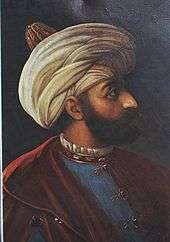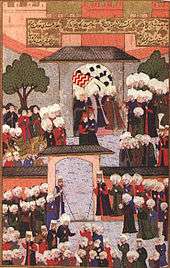Nurbanu Sultan
| Afife Nurbanu Sultan نور بانو سلطان | |
|---|---|
|
Valide-i saadet-penah Mahd-i Ulya Sultanat El-Mütevekkil ala'llah El-melikü'l-mennan Valide-i Padişah | |
|
The türbe of Nurbanu located next to that of Selim II in the courtyard of Hagia Sophia | |
| Valide Sultan of the Ottoman Empire | |
| Tenure | 15 December 1574 – 7 December 1583 |
| Predecessor | Hafsa Sultan |
| Successor | Safiye Sultan |
| Haseki Sultan of the Ottoman Empire | |
| Tenure | 7 September 1566 – 15 December 1574 |
| Predecessor | Hürrem Sultan |
| Successor | Safiye Sultan |
| Born |
Cecilia Venier-Baffo or Rachel or Kalē Kartanou c. 1525 Paros, Cyclades Islands, Republic of Venice? |
| Died |
7 December 1583 (aged 58) Istanbul, Ottoman Empire |
| Burial | Hagia Sophia Mosque, Istanbul |
| Spouse | Selim II |
| Issue |
Murad III Ismihan Sultan Gevherhan Sultan Şah Sultan Fatma Sultan (?) |
| Religion | Islam, previously Roman Catholic or Jewish or Greek Orthodox |
Afife Nurbanu Sultan (Ottoman Turkish: نور بانو سلطان; c. 1525[1] – 7 December 1583) was Haseki Sultan of Ottoman as principal consort and legal wife of Sultan Selim II and Valide Sultan of Ottoman as mother of Sultan Murad III. Conflicting theories ascribe her a Venetian, Jewish[2] or Greek[3] origin. Her birth name may have been Cecilia Venier-Baffo,[4] Rachel[5] or Kalē Kartanou.[6] Nurbanu was one of the prominent figure during the era known as Sultanate of Women.
Theories about her origin
There are several theories about the ethnic roots of Nurbanu, none of which is generally accepted:
Jewish origin
Turkish historian Ahmet Refik believed she was of Jewish descent,[7] followed by some Turkish historians.[1]
Cecilia Venier-Baffo
The Venetian claimed she was a daughter of Nicolò Venier and Violanta Baffo, abducted in Paros island when it was captured by Hayreddin Barbarossa.[6]
Kalē Kartanou
In 1992, B. Arbel challenged the view that she was really of Venetian descent. For him the most plausible theory is that she was a Greek from Corfou named Kale Kartanou.[6]
Haseki Sultan

Nurbanu became the most favored consort of Ottoman Sultan Selim II, who was put on the throne in 1566, and the mother of Murad III.
While her spouse Selim still a şehzade, Nurbanu had been the head of his princely harem at Manisa. However, when Selim ascended to the throne, she was not head of the imperial harem, as that was a position taken by Selim's elder sister Mihrimah Sultan.
Even after Selim as a sultan began to take other concubines, she persisted as a favorite for her beauty and intelligence. As mother of the heir-apparent, she acted as an advisor to her husband. Although it was far from normal at the time, Selim II would often ask Nurbanu for her advice on various subjects because of his respect for her good judgment. Jacopo Soranzo, Venetian Ambassador reported:
"The Haseki is said to be extremely well loved and honored by His Majesty both for her great beauty and for being unusually intelligent."[8]
She was a devoted wife and a very loyal mother as later events would prove. The Ottoman Empire was far from being very stable at the top and clashes over the imperial throne were common. It was also not uncommon for the loser to have his entire family massacred along with him to prevent any future challenge. Nurbanu Sultan was determined, however, that when the time came for her son to succeed his father, nothing would interfere with that.
At the end of Selim II's reign, the haseki Nurbanu received 1,000 aspers a day, while Selim's other consorts, each the mother of son, received only 40 aspers.[9]
Valide Sultan and regent

Şehzade Murad had been sent to serve as Governor of Manisa on the Aegean coast and was there when Sultan Selim II died in 1574. This would have been the perfect opportunity for someone to seize power with the Sultan dead and his son away from the capital. Nurbanu realized this as much, if not more, than anyone and took quick action. Security and privacy in the harem were the most strict anywhere and no one knew when Selim II had actually died. Nurbanu told no one and hid the dead body of her husband in an icebox and sent to Manisa for her son to come to Constantinople immediately. All the while no one was the wiser that Sultan Selim II had actually departed this life. It was not made known publicly until twelve days later when Murad arrived and Nurbanu delivered up the body of her late husband. Her son became Sultan Murad III and Nurbanu became Valide Sultan, the highest position a woman could hold in the Ottoman Empire. Unlike her predecessor Hürrem Sultan, Nurbanu outlived her husband and enjoyed absolute power between 1574 and 1583, although she was apparently not resident in the Palace after Selim II's death. Nurbanu had ultimate power, and she became a formidable figure with far-reaching influence. Canfeda Hatun, Raziye Hatun, and Hubbi Hatun ladies-in-waiting to Murad and Nurbanu also appear to have been very powerful and influential during his reign.[10][11]
Foreign politics
After Nurbanu became the valide sultan to her son Murad III, she effectively managed the government together with the Grand Vizier Sokollu Mehmed Pasha, who acted as co-regent with the sultan during the Sultanate of Women. Her intermediary to the world outside the harem was her "kira", Esther Handali. "Kira" was so popular means of communication with the outside world when Nûr-Banû was the Valide Sultan that the two women were said to have been lovers. She corresponded with the queen Catherine de' Medici of France. Venetian accounts are the most prolific in describing Nurbanu Sultan as a woman who never forgot her Venetian origins.

During her nine years of regency (1574–1583), her politics were so pro-Venetian that she was hated by the Republic of Genoa. Some have even suggested that she was poisoned by a Genoese agent. In any case, she died at the palace in the Yenikapı Quarter, Istanbul on 7 December 1583. Moreover, it has been said that Nurbanu was related to Safiye Sultan, who was born Sofia Baffo, married Murad III, and consequently became the next valide sultan of the Ottoman Empire when her own son Mehmed III acceded to the throne. On the other hand, the Ottoman records claim that the Republic of Venice became highly dependent on the Ottoman Empire during the regency of Nurbanu because her policies were allegedly extremely pro-Jewish.
Charitable establishments and philanthrophy
During her nine years of regency, Nurbanu ordered the renowned Ottoman architect Mimar Sinan to build the Atik Valide Mosque and its surrounding külliye at the district of Üsküdar in Istanbul, where previously a "Jewish bath" was located. The construction of the külliye was completed and put in commission at the end of 1583, just before the demise of Nurbanu on 7 December 1583. She was buried at the mausoleum of her husband Selim II located inside the Hagia Sophia (then a mosque) at Sultanahmet in Istanbul, Turkey.
Death
Nurbanu died in Istanbul, 7 December 1583, during reign of her son Murad III. She was buried next to that of Selim II in the courtyard of Hagia Sophia.
See also
- Ottoman Empire
- Ottoman dynasty
- Ottoman family tree
- List of Valide Sultans
- List of sultans of the Ottoman Empire
- Line of succession to the Ottoman throne
- Ottoman Emperors family tree (simplified)
- List of consorts of the Ottoman Sultans
References
Notes
- 1 2 A.H. de Groot, s.v. in Encyclopaedia of Islam vol.8 p.124
- ↑ Stanford J. Shaw, History of the Ottoman Empire and modern Turkey, Volume 1, p. 178, at Google Books
- ↑ Arbel, Benjamin, Nur Banu (c. 1530-1583): A Venetian Sultana?
- ↑ Godfrey Goodwin, The Private World of Ottoman Women, Saqi Book, ISBN 0-86356-745-2, ISBN 3-631-36808-9, 2001. page 128,
- ↑ Valeria Heuberger, Geneviève Humbert, Geneviève Humbert-Knitel, Elisabeth Vyslonzil, Cultures in Colors, page 68. ISBN 3-631-36808-9, 2001
- 1 2 3 Arbel, Benjamin, Nur Banu (c. 1530-1583): A Venetian Sultana?, Turcica, 24 (1992), pp. 241-259.
- ↑ Çağatay Uluçay, Padişahların Kadınları ve Kızları p.68, citing Kadınlar Saltanatı I p.95
- ↑ Peirce 1993, p. 228.
- ↑ Peirce 1993, p. 129.
- ↑ Maria Pia Pedani Fabris, Alessio Bombaci (2010). Inventory of the Lettere E Scritture Turchesche in the Venetian State Archives. BRILL. p. 26. ISBN 978-9-004-17918-9.
- ↑ Petruccioli, Attilio (1997). Gardens in the Time of the Great Muslim Empires: Theory and Design. E. J. Brill. p. 50. ISBN 978-9-004-10723-6.
Bibliography
- Arbel, Benjamin, Nur Banu (c. 1530-1583): A Venetian Sultana?, Turcica, 24 (1992), pp. 241–259.
- Peirce, Leslie Penn (1993). The Imperial Harem: Women and Sovereignty in the Ottoman Empire. Studies in Middle Eastern History. New York: Oxford University Press. ISBN 978-0-19-507673-8.
- A.D. Alderson, The Structure of the Ottoman Dynasty. Clarendon Press, Oxford, 1956.
- Almanach de Gotha: annuaire généalogique, diplomatique et statistique, Justes Perthes, Gotha, 1880-1944.
- Burke's Royal Families of the World, Volume II: Africa & The Middle East, Burke's Peerage Ltd., London, 1980.
- A.H. de Groot, s.v. in Encyclopaedia of Islam vol.8 p. 124
- Yılmaz Öztuna, Devletler ve Hanedanlar, Turkiye 1074-1990, Ankara, 1989.
- Osman Selâheddin Osmanoğlu, Osmanli Devleti'nin Kuruluşunun 700. Yılında Osmanlı Hanedanı, Islâm Tarih, Sanat ve Kültür Araştırma Vakfı (ISAR), Istanbul, 1999.
- Emine Fuat Tugay, Three Centuries: Family Chronicles of Turkey and Egypt, Oxford, 1963.
External links
| Ottoman royalty | ||
|---|---|---|
| Preceded by Hürrem Sultan |
Haseki Sultan 7 September 1566 – 15 December 1574 |
Succeeded by Safiye Sultan |
| Preceded by Hafsa Sultan |
Valide Sultan 15 December 1574 – 7 December 1583 | |